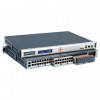Lantronix SLC 8000 Advanced Console Manager User Guide - Page 194
Modem Settings: Text Mode, Dial-in Host List
 |
View all Lantronix SLC 8000 Advanced Console Manager manuals
Add to My Manuals
Save this manual to your list of manuals |
Page 194 highlights
9: Device Ports Use Sites Initialization Script Modem Timeout Caller ID Logging Modem Command Dial-Back Number Dial-Back Delay Dial-Back Retries Enables the use of site-oriented modem parameters which can be activated by various modem-related events (authentication, outbound network traffic for dialon-demand connections, etc.). Sites can be used with the following modem states: dial-in, dial-back, dial-on-demand, dial-in & dial-on-demand, dial-back & dial-on-demand, and CBCP server. Commands sent to configure the modem may have up to 100 characters. Consult your modem's documentation for recommended initialization options. If you do not specify an initialization script, the SLC unit uses a default initialization string of AT S7=45 SO=0 L1 V1 X4 &D2 &c1 E1 Q0. Note: We recommend that the modem initialization script always be preceded with AT and include E1 V1 x4 Q0 so that the SLC 8000 advanced console manager may properly control the modem. For information on AT commands, refer to the modem user guide, or do a web search for at command set. Serial modems may need to include &B1 in the modem initialization string to set the DTE rate to a fixed baud rate. Timeout for all modem connections. Select Yes (default) for the SLC unit to terminate the connection if no traffic is received during the configured idle time. Enter a value of from 1 to 9999 seconds. The default is 30 seconds. Select to enable the SLC advanced console manager to log caller IDs on incoming calls. Disabled by default. Note: For the Caller ID AT command, refer to the modem user guide. Modem AT command used to initiate caller ID logging by the modem. Note: For the AT command, refer to the modem user guide. Users with dial-back access can dial into the SLC device and enter their login and password. Once the SLC 8000 advanced console manager authenticates them, the modem hangs up and dials them back. Select the phone number the modem dials back on -a fixed number or a number associated with their login. If you select Fixed Number, enter the number (in the format 2123456789). The dial-back number is also used for CBCP client as the number for a userdefined number. See Device Ports - Settings (on page 186) for more information. For dial-back and CBCP Server, the number of seconds between the dial-in and dial-out portions of the dialing sequence. For dial-back and CBCP Server, the number of times the SLC unit will retry the dial-out portion of the dialing sequence if the first attempt to dial-out fails. Modem Settings: Text Mode Timeout Logins Dial-in Host List If you selected Text mode, you can enable logins to time out after the connection is inactive for a specified number of minutes. The default is No. This setting is only applicable for text mode connections. PPP mode connections stay connected until either side drops the connection. Disabled by default. From the drop-down list, select the desired host list. The host list is a prioritized list of SSH, Telnet, and TCP hosts that are available for establishing outgoing modem connections or for connect direct at the CLI. The hosts in the list are cycled through until the SLC 8000 advanced console manager successfully connects to one. To establish and configure host lists, click the Host Lists link. See "Host Lists" on page 216. SLC™ 8000 Advanced Console Manager User Guide 194















